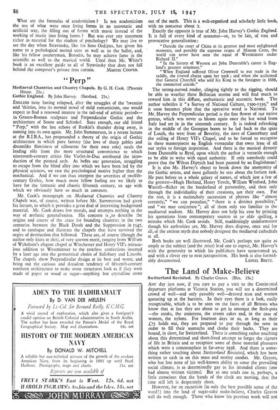P er . 19
Mediaeval ChantrIes and Chantry Chapels. By G. H. Cook. (Phoenix House. 21s.) Gothic England. By John Harvey. (Batsford. 21s.)
ENGLISH taste having relapsed, after the struggles of the 'twenties and 'thirties, into its normal mood of mild romanticism, one would expect to find a renewed interest in the tail-end of artistic periods— in Graeco-Roman sculpture and Perpendicular Gothic and the architecture of Soane and Schinkel. Sure enough, our old friend " Perp," with the last echoes of Ruskin's thunder dying away, is coming into its own again. Mr. John Summerson, in a recent lecture at the R.I.B.A., has propounded a theory of the origin of Gothic architecture in which pure fantasy (the love of sharp gables and dreamlike flimsiness of silhouette for their own sake) steals the leading role from the mere structural convenience to which nineteenth-century critics like Viollet-le-Duc attributed the intro- duction of the pointed arch. As befits our generation, struggling to escape from the blind alley into which we have been led by the physical sciences, we rate the psychological motive higher than the mechanical. And if we can thus interpret the severities of twelfth- century Gothic, how much more fellow feeling are we likely to have for the fantastic and chaotic fifteenth century, an age with which we obviously have so much in common.
Mr. Cook's monograph on Mediaeval Chaptries and Chantry Chapels was, of course, written before Mr. Summerson had given his lecture, to which it provides a great deal of interesting background material. Mr. Cook draws few morals, and attempts nothing in the way of aesthetic generalisation. His concern is to describe the origins and course of the craze for founding chantries in the two centuries between the Black Death and the Suppression in 1547, and to catalogue and illustrate the chapels that have survived the orgies of destruction that followed. These are, of course (though the author only hints at this), of very uneven merit, ranging from William of Wykeham's elegant chapel at Winchester and Henry VII's miracu- lous addition to Westminster to the tasteless confections inserted by a later age into the geometrical choirs of Salisbury and Lincoln. The chapels show Perpendicular design at its best and worst, and bring out the curious and decadent tendency of fifteenth-century northern architecture to make stone structures look as if they were made of paper or wood or sugar—anything but crystalline stone out of the earth. This is a well-organised and scholarly little book, with no nonsense about it.
Exactly the opposite is true of Mr. John Harvey's Gothic England. It is full of every kind of nonsense—or, to be fair, of vast and provocative generalisation:
" Outside the court of China at its greatest and most enlightened moments, and possibly the supreme reigns of Minoan Crete, the world can never have seen the equal of Westminster under Richard II."
" In the history of Western art John Dunstable's career is Eng- land's greatest ornament."
" When England suffered Oliver Cromwell to put trade in the saddle, she riveted chains upon her neck ; and when she acclaimed that General Churchill who sold his King to the foreigner in 1688, she committed suicide."
The strong-nerved. reader, clinging to the rigging, should be able to weather these Bellocian storms and will find much to reward him in this diffuse, enthusiastic and eccentric book. The author subtitles it " a Survey of National Culture, 1300-1550," and it soon becomes plain that the operative word is National. To Mr. Harvey the Perpendicular period is the fine flower of our native genius, which was never to bloom again once the hot wind from Italy had set in in the sixteenth century. It is indeed refreshing in the middle of the Georgian boom to be led back to the spire of Louth, the west front of Beverley, the nave of Canterbury and the ceiling of Henry VIPs Chapel, and to be forced to recognise in these masterpieces an English vernacular that owes least of all our styles to foreign inspiration. And there is the musical dynasty from Dunstable to Byrd, upon which the author is versatile enough to be able to write with equal authority. If only somebody could prove that the Wilton Diptych had been painted by an Englishman!
It is also Mr. Harvey's object to break down the anonymity of the Gothic artists, and most gallantly he sets about the forlorn task. He puts before us a whole galaxy of names, of which just a few of the greatest—Hugh Herland, Henry Yevele, William Wynford, John Wastell—flicker on the borderland of personality, and then only= through the individuality of their creations, not their own. For the rest, it is a melancholy succession of phrases like " almost certainly," " we can postulate," " there is a distinct possibility," and " we may conjecture "; all of them only too familiar to the mediaeval student. Mr. Harvey does not help his case by printing his quotations from contemporary sources in ye olde spelling, a mistake which Mr. Cook avoids. Still, maddeningly uninformative though his authorities are, Mr. Harvey does dispose, once and for all, of the ancient myth that nobody designed the mediaeval- cathedrals at all.
Both books are well illustrated, Mr. Cook's perhaps not quite as amply as the subject (and the price) lead one to expect, Mr. Harvey's with the generosity to which his publishers have accustomed us, and with a clever eye to neat juxtaposition. His book is also formid-
ably documented. LIONEL BRETT.


































 Previous page
Previous page